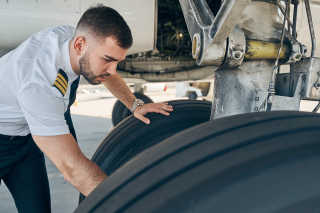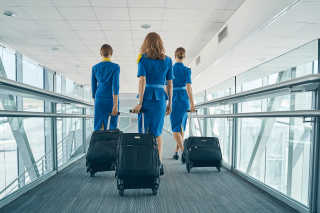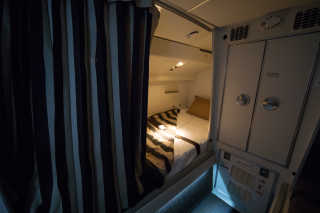Fun Facts About Flight Crews
If you've ever been on a plane, I'm sure you've wondered just what goes on up there! Do pilots take bathroom breaks? How many pilots are on each plane? What are all those checks they do before and after the flight and can they skip security checks at the airport? We've compiled some fun facts about flight crews so you can get to know how things work for airline crews behind the scenes!
- Do pilots actually fly the planes?
- What are pilots checking pre/post-flights?
- What do the cabin crews do prior to passengers embarking/disembarking the airplane?
- Do they work with the same team?
- How often do pilots have to go the bathroom?
- Where does the crew sleep?
- Do crew skip airport security?
- Why do some airplanes have three pilots? What does the third pilot do?
- How many hours are pilots allowed to fly a day?
- Does the crew eat the same food as the passengers?
Do pilots actually fly the planes?
Pilots typically fly the plane during take off and landing. The pilot manually controls the plane until it reaches the required height. This usually only takes about five minutes. After that the pilot will usually engage the auto-pilot. If the weather is very poor or changes unexpectedly, the pilot will once again take charge of the plane. If there is an emergency situation, the pilot or co-pilot will manually fly the plane to make sure that the plane and passengers stay safe.
What are pilots checking before and after the flight?
Pilots have to check certain mechanical and digital parts of the plane before and after each flight. The check-list is important and helps to make sure that everything on the plane is in working order and that any problems before, during or after the flight are recorded. These checks are done by every pilot who flies any plane - large or small. These special pre-flight checks were introduced by the Boeing Corporation in 1935 after a Boeing prototype plane crashed when pilots forgot to disengage the gust locks. Pilots will check the outside of the plane, brakes, electrical equipment and engine components, like ignition and oil pressure.

What do the cabin crews do prior to passengers embarking/disembarking the airplane?'
Cabin crews are responsible for the cabin and the passengers' needs - they also make sure that in-flight safety equipment works and explain how to use it when passengers board. They will also make sure that the cabin is clean, including the kitchen and bathrooms and that any information in the passenger seat-pockets is up to date, take responsibility for on-board meals and welcome passengers as they embark. Before disembarking, flight attendants remind passengers of the correct exits and procedures, including any security checks and the correct gates of entry and exit.
Do they work with the same team?
Flight crews are not always working with the same team members. Crews work on various flights at different times and the plane may fly out with one crew and fly back with a different one. Smaller airlines with fewer staff raise the chances of flying with a regular team, while it's not that likely on major airlines. The more flights that are taken by the staff means a greater chance of working with the same flight attendants and pilots.

How often do pilots have to go the bathroom?
Long and short distance pilots are allowed to use the bathroom when they need to as long as the airplane is under control. Pilots use the same bathroom as the passengers, much to the delight of the younger (and sometimes older) people on board! They also eat and drink during flights - usually being served beverages and their meals in the cockpit by the cabin crew. Sometimes you can ask to visit the cockpit of the plane where you can meet the pilot and co-pilot but this should always be by special arrangement.
Where does the crew sleep?
Long-distance flights can last for 12 hours or more so, for everybody's safety, crew members need to rest. Hidden away above the main cabin and accessed by a discreet staircase are 'secret' sleeping quarters with several beds and a bathroom. Even the captain takes a mid-flight break.

Do crew skip airport security?
This can depend on the country or airports within certain countries. Airports require all staff, including flight crews, to **go through the same metal detectors as general passengers. Some airports may have a less restricted policy, for example, pilots and flight attendants not having to go through a full screening, including pat-down. These policies may change if there is a known or direct threat in the immediate area or as management policies are updated. Some airports may also have special queues that are designated only for flight crews.
Why do some airplanes have three pilots? What does the third pilot do?
Long haul flights must have two or three pilots on board. International flights can last for several hours and the security of the plane and the passengers is very important. If a pilot gets ill, gets injured or for some reason cannot fly the plane, the plane and passengers becomes the responsibility of the co-pilot. If there are three pilots on board one will be the captain who flies the plane, the second will be the first officer or co-pilot. The third pilot is the flight engineer. Flight engineers make sure that all the onboard equipment is working properly and monitors digital and mechanical information during the flight.

How many hours are pilots allowed to fly a day?
This may vary very slightly from country to country and between airlines, but pilots are usually allowed to fly around nine hours a day. At night, they are allowed to fly for eight hours. It can depend on how many segments are flown and what time the pilot started flying as well as whether there is a break between flights. Pilots can can fly up to fourteen hours in a single day, if breaks are taken between shorter flights. Pilots are allowed to sleep during long and short flights as long as this is done under very strict conditions. This is to avoid pilot fatigue.
Does the crew eat the same food as the passengers?
Cabin crew meals may be based on individual dietary needs and preferences, but usually they are the same quality and meal enjoyed by the passengers onboard. However, there's one common rule in the aviation world. The captain and co-pilot do not eat the same meals in case they both come down with food poisoning, putting the plane's safety at risk.

For more information on flights to different destinations around the world and to compare all our best prices visit BudgetAir.com!

